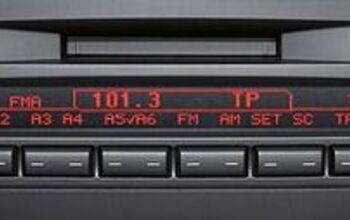The Truth About Automotive Electronics Pt 2: The Bad
Retired Israeli Air Force ace Giora Epstein flew Mirage, Nesher and F-16 fighter aircraft during his career. When asked by the History Channel which aircraft he preferred, he replied “In the Mirage and the Nesher, the pilot flies the aircraft. In the F-16, the computer flies the aircraft and the pilot is just another input to the computer.” Modern automotive electronics have transferred Epstein’s complaint to millions of cars. We may purchase and maintain our vehicles, but we no longer truly drive them. Increasingly, we’re mere inputs for the computers that do.
This experience may be mostly transparent, but it is real. Press on the ‘gas’ pedal of an electronic-throttle car and it doesn’t open the throttle; it simply tells the engine computer the desired torque output.The brake pedal of a Toyota Prius doesn’t activate the brakes; it tells the ABS computer how much braking to supply. Turn the steering wheel in an Active Steering-equipped BMW and the direction change ranges from barely-noticeable to “Holy s***!”, depending upon what the Active Steering system decides is appropriate.
Under most circumstances, drivers don’t know or care that computers are intermediating their driving. But sometimes it does matter. Lift off an electronic throttle pedal and the computer may ignore it, holding the throttle open to reduce smog emissions. Panic brake in deep snow and ABS may threshold-brake the car into an intersection, when locked brakes might have stopped it much sooner. Try to ‘rock’ a vehicle out of slush and the traction control system may steadfastly thwart the effort.
This lack of control particularly frustrates driving enthusiasts. They want engine braking at lift-throttle, not when the computer decides they can have it. They want to take their favorite corner in a lurid tail-out slide, not electronic nannies telling them that they can’t. It’s a real killjoy when the HAL 9000 controlling the transmission rejects a downshift with an “I’m sorry Dave, I’m afraid I can’t do that.” Or when the simple act of simultaneously pushing the brake and accelerator pedals sets off an electronic hissy-fit.
Even when the pocket-protector set tries to apply their dark arts for enthusiasts, they usually end up spoiling the fun. At the extreme end, Formula 1 banned electronic driver aids in the early 1990s (the ban has since been modified) because winning became more a function of software engineering than driver skill. Lower down the food chain, automakers have no qualms whatsoever about rendering their sports-oriented customers’ driving skills irrelevant.
Several high end automakers now offer transmission ‘launch control’ modes, where a driver simply selects the mode and floors the accelerator. Maximum acceleration is provided; no clutch modulation skills required. The new F430 Scuderia is equipped with F1-Trac traction control, which Ferrari test drivers admit allows ordinary drivers to nearly match their lap times around Fiorano.
Where is the pride in mastering driving skills when any Tom, Dick or Harriet can duplicate them by pushing a button? The piss-ant paradigm now extends to off-roading, where Land Rovers offer Fisher-Price type buttons that configure a vehicle’s various e-Nannies for various terrains. Hill Descent Control allows feet free operation. No muss. No fuss. No skill. No fun.
Ordinary drivers have a different interaction with all this automotive electronic wizardry. It makes them worse drivers.
The National Highway Traffic Safety Administration estimates that about 25 percent of all American automobile accidents are caused by distracted drivers. That’s plain to see. Cruise the freeways in any U.S. urban area. Clock how many drivers are talking on their cell phones, fiddling with their iPods, checking their navigation screens, playing with their iDrive/COMAND/MMI interfaces, or looking for the Teletubbies disc for the onboard DVD player. Their focus is everywhere but their driving.
ABS, panic brake assist and stability control can help prevent an accident, but they can’t make the car brake or steer. Only an attentive driver can do that.
Automotive electronics are also dumbing down drivers through the subtle action of moral hazard. The old anti-driver’s aids shibboleth says that cars should be equipped with sharp spikes instead of airbags, to encourage drivers to drive very carefully. Perhaps. Meanwhile, manufacturers give them an electronically expanded safety envelope. Drivers respond to this safety net by driving more aggressively. As a result, the safety benefits of technology are cancelled out by dumber driving.
Studies indicate that ABS-equipped cars have about the same accident rate as their non-ABS equivalents. Similarly, automotive forums bristle with stories about highway medians filled with flipped-over SUVs whose drivers thought 4WD was synonymous with “invincibility.”
History indicates that as drivers adapt to these new technologies, many of the problems associated with them will decline. But there are other ticking time bombs in the automotive electronic world. In our next installment, we’ll look at the long-term implications of these high-tech wonders.
More by Eric Stepans
Latest Car Reviews
Read moreLatest Product Reviews
Read moreRecent Comments
- Cprescott The problem with this fable by the FTC is:(1) shipping of all kinds was hindered at ports because of COVID related issues;(2) The President shafted the Saudis by insulting them with a fist bump that torqued them off to no end;(3) Saudis announced unilateral production cuts repeatedly during this President's tenure even as he begged to get them to produce more;(4) We were told that we had record domestic production so that would have lowered prices due to increased supply(5) The President emptied the strategic petroleum reserve to the lowest point since the 1980's due to number 3 and then sold much of that to China.We have repeatedly been told that documents and emails are Russian disinformation so why now are we to believe this?
- Ollicat Another Biden attempt to say, "Look over there!"
- Kjhkjlhkjhkljh kljhjkhjklhkjh Who cares. Price of gas is not the issue. spending an extra 100$ a month over 4 tanks of gas is not the issue.this a political scam to distract really dumb people from the real issue. if rent and house payments were not up by 50% to as high as 150% higher in a ton of locations, then paying an extra 100$ in gas would be annoying but not really an issue. But the real-estate market with hedge fund investors, power-relator groups bought a ton of houses and flipped them into rentals and jacked up the rates uplifting the costs on everything else. and ironically no-one seems to be in any hurry to build more houses to bring those costs down because supply and demand means keeping less houses available to charge as much as you want. It is also not the issue as a secondary issue is child care costs and medical... again 100$ extra per month in gas is *nothing* compared to 800$ a month in ''child care'' and 300$ per visit to the doctor office, 300$ for a procedure less dentist trip..
- Ajla Is there something proprietary or installed on the moon with these that I'm not aware of?
- Tane94 Awaiting the EV3 unveil this month. Kia continues to lead, though I will miss the Soul

































Comments
Join the conversation
The F-16 flight control system system (computers) is necessary due to the limitations of the pilot and the built in instability of the bird. Current fighter design is working to further reduce the limitations of the pilot by removing him/her entirely. Humans cannot think fast enough, have relatively poor senses, cannot stand much more than 8 Gs, require all sorts of heavy expensive life support equipment, and cannot be counted on to do the right thing consistently. Elimination of the driver as the limiting factor seems to be the way car design is going as well. No driver, just passengers.
I couldn't agree more about badly done safety systems. My V6 Camaro nearly killed me more than once when I tried to whistle up oversteer and the traction control computer denied it by fiddling with the front brakes, leading to the car pushing instead of rotating, and me headed into a wall. If I'd just driven it like the idiot GM assumed I was, I'd have turned the wheel and let the traction control pull the front end around for me, which actually worked the few times it snuck up on me. However, I learned to drive in farm trucks, and rear-wheel handling is in my blood. I can feel the rear end snap out on me and fix it. With the traction control computer 'helping', the job gets a lot harder, as we fight each other and the rather coarse rear end. The killer, though, was that the alternator on that Camaro was not powerful enough to handle the traction control system for an extended period, so a session doing donuts in a parking lot burned up my alternator in the dead of winter. How's that for an unintended consequence?